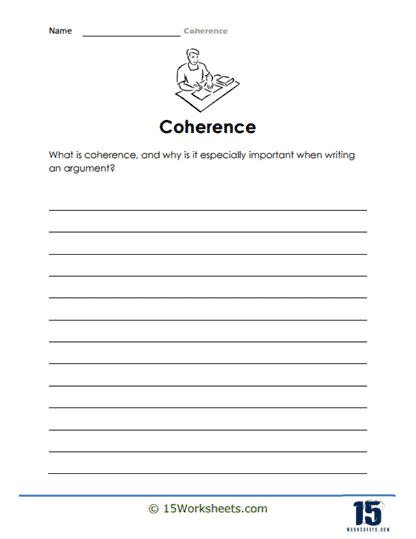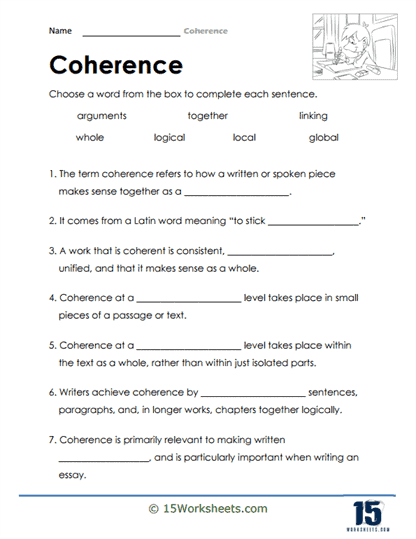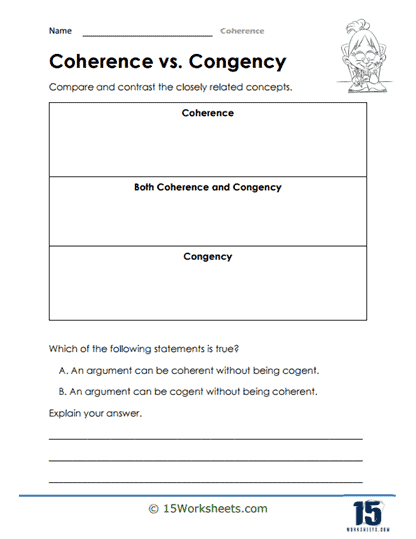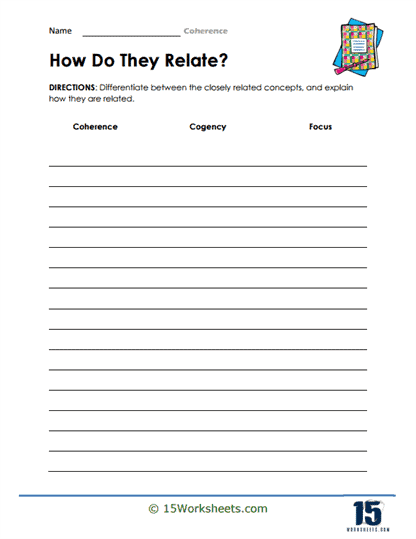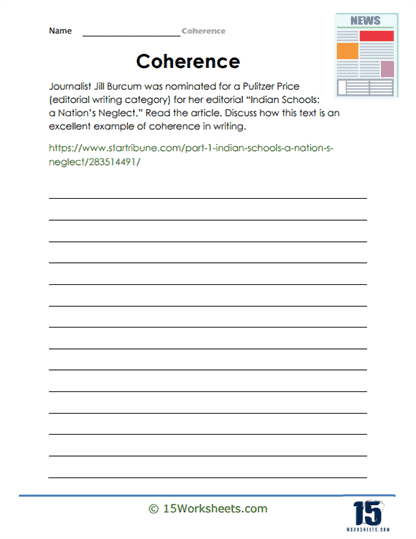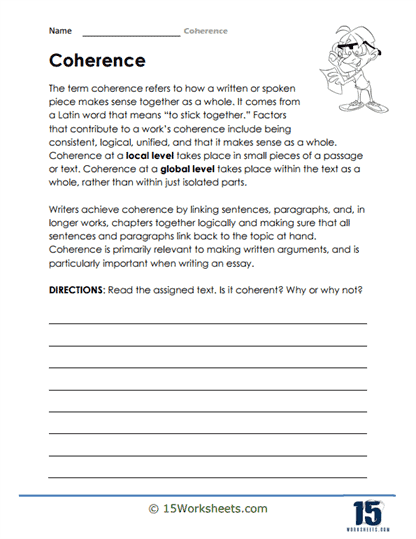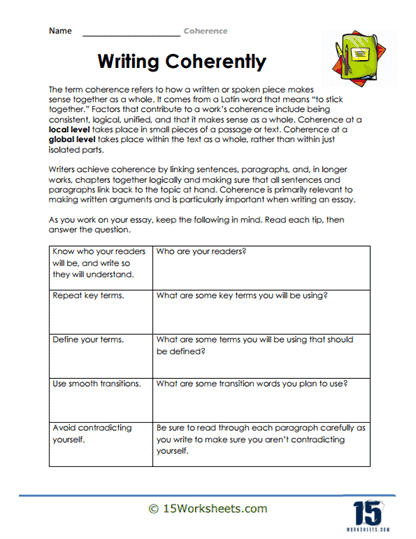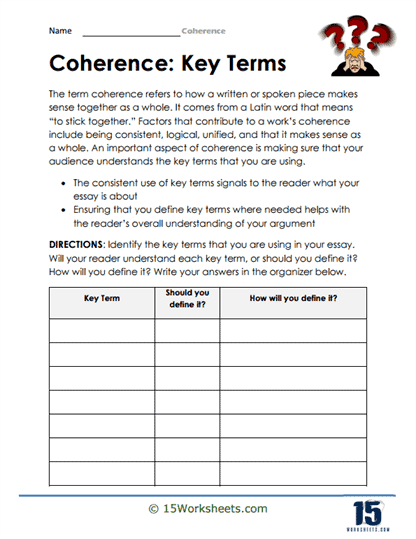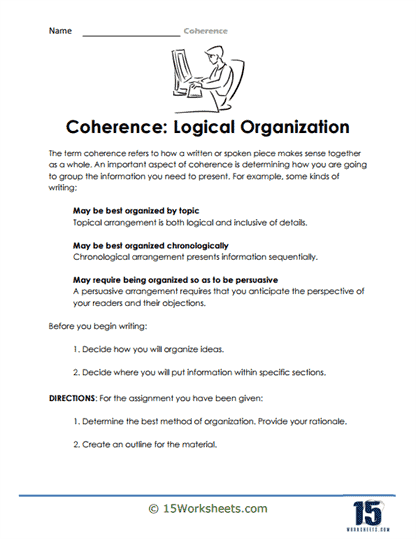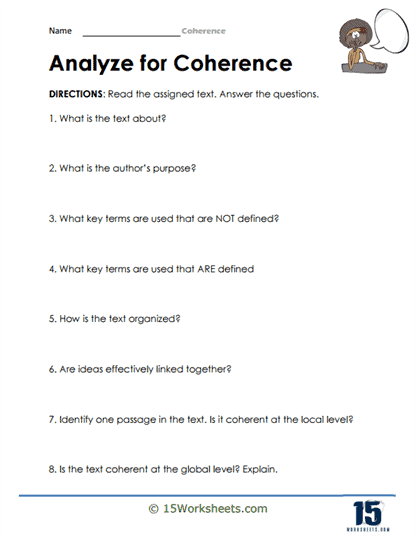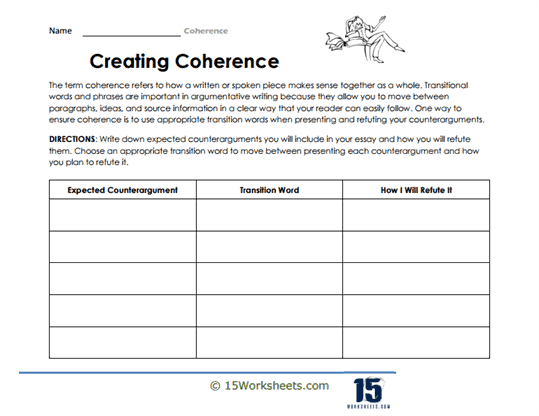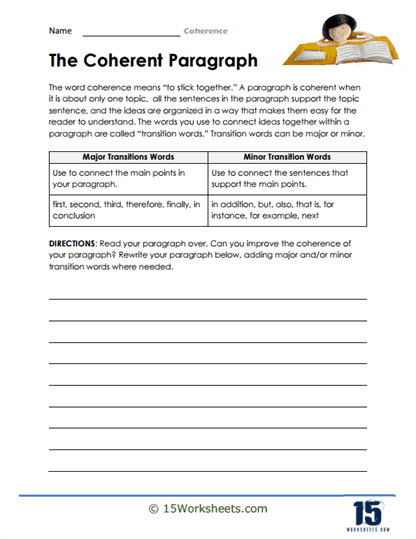Coherence Worksheets
About These 15 Worksheets
Coherence in writing is the logical bridge between words, sentences, and paragraphs that ensures the text is understandable and flows smoothly from one point to the next. These worksheets work to enhance students’ abilities to create cohesive and logically structured pieces of writing. These worksheets incorporate a variety of exercises aimed at improving students’ understanding and application of coherence in language arts, including reading and writing skills. By engaging with these exercises, students develop a keen eye for the flow of ideas, learn to organize their thoughts more effectively, and enhance their overall communication abilities.
The diverse exercises found on these worksheets not only improve students’ writing and reading comprehension but also equip them with critical thinking, organization, and communication skills. By regularly practicing with coherence worksheets, students develop a robust understanding of how to effectively convey their ideas, making them more competent and confident writers and readers. This foundation is crucial for academic success across all subjects and for effective communication in their future personal and professional lives.
Types of Exercises
Coherence worksheets include a broad range of exercises tailored to address different aspects of coherence in writing. These exercises are crucial for developing students’ abilities to construct clear and logical narratives, arguments, and expositions.
Paragraph Ordering – These exercises present students with jumbled paragraphs or sentences that they must rearrange into a logical sequence. This activity helps students understand how ideas flow from one to another, enhancing their ability to structure their writing cohesively.
Transition Words Practice – Students fill in blanks or choose the correct transition word or phrase that best connects ideas within sentences or between paragraphs. This practice familiarizes students with the use of transitional elements that guide readers through the text, highlighting relationships between ideas.
Thematic Unity Exercises – Here, students evaluate a set of sentences or paragraphs to determine whether they all contribute to the main theme or topic. This exercise enhances students’ skills in maintaining focus on the central idea, a key aspect of coherent writing.
Creating Outlines – Students are tasked with creating outlines for essays or stories based on provided prompts or themes. By organizing their ideas hierarchically before writing, students learn to plan coherent structures for their texts.
Coherence in Argumentative Writing – These exercises focus on building coherent arguments by ensuring that each claim is directly supported by evidence and that all parts of the argument are logically connected. Students might work on strengthening the coherence of weak arguments by adding, removing, or rearranging elements.
Summarization Tasks – Summarizing a text requires understanding its main points and how they are connected. Exercises that ask students to summarize readings in a coherent manner push them to distill complex ideas into concise, logical sequences.
Identifying Incoherence – Some exercises present students with intentionally incoherent texts, asking them to identify and correct the incoherencies. This not only sharpens their editing skills but also deepens their understanding of what makes a text coherent.
The Benefits of These Worksheets
Practicing with coherence worksheets significantly benefits students’ language arts and reading skills in several ways:
Enhanced Reading Comprehension – By working on exercises that demand a deep understanding of how ideas are connected within a text, students improve their reading comprehension. They become better at identifying the main ideas and the logical flow of arguments or narratives.
Improved Writing Quality – As students gain mastery over the tools and techniques for creating coherence, the overall quality of their writing improves. Their texts become more logical, easier to follow, and more persuasive or engaging, depending on the purpose.
Increased Vocabulary and Use of Transitional Phrases – The frequent use of transition words and phrases in coherence exercises expands students’ vocabulary and improves their ability to use these linguistic tools effectively, making their writing smoother and more sophisticated.
Better Organization Skills – Exercises that involve ordering paragraphs or creating outlines enhance students’ ability to organize their thoughts and ideas before writing, leading to more structured and coherent final texts.
Critical Thinking and Analysis – Identifying incoherence in texts or working to improve the coherence of an argument requires analytical skills and critical thinking. Students learn to evaluate the strength of connections between ideas, enhancing their analytical abilities.
Editing and Revision Skills – Coherence worksheets often involve tasks that mimic the editing and revision process, teaching students to view their own and others’ writing with a critical eye. They learn to spot and correct incoherencies, improving the overall clarity and flow of the text.
Adaptability in Communication – Through varied exercises, students learn that coherence is not just about stringing sentences together but about crafting a narrative or argument that is logically structured and purposeful. This understanding makes them more adaptable communicators, capable of adjusting their writing to suit different purposes and audiences.
What is the Literary Device of Coherence?
Coherence in literature refers to the logical and consistent interconnection of ideas in a text that ensures clarity and comprehensibility for the reader. It is the glue that holds the narrative, arguments, or poetic constructs together, enabling the text to be understood as a cohesive whole rather than a disjointed collection of parts. The primary defining feature of coherence is the seamless flow of thought that guides the reader through the text, making connections between ideas, events, and characters clear and intuitive.
Main Defining Feature of Coherence
The essence of coherence lies in its creation of a unified and logical structure within a text. This structure allows the reader to follow the author’s line of thought or narrative path without confusion. Coherence ensures that each part of the text contributes to the development of a central theme or argument, with each sentence, paragraph, and chapter building upon the previous ones in a way that is easy for the reader to understand and follow.
Characteristics of Coherence
Logical Progression – A coherent text exhibits a clear and logical progression of ideas or narrative events. This logical sequence ensures that the reader can follow the development of the text without becoming lost or confused.
Consistency – Coherence requires consistency in the use of details, character development, and thematic elements throughout the text. Inconsistencies can disrupt the reader’s understanding and engagement with the text.
Clarity – Clear expression of ideas is fundamental to coherence. The use of precise language and well-defined terms helps prevent ambiguity and misunderstanding.
Use of Transitional Devices – Coherent texts often employ transitional words and phrases to signal relationships between ideas or shifts in the narrative, guiding the reader smoothly from one element to the next.
Unity – Every component of a coherent text contributes to its overall unity. Whether it’s a chapter, paragraph, or sentence, each piece serves a purpose in advancing the text’s central theme or argument.
Examples of Coherence in Literature
The examples from Austen, Shakespeare, and Orwell demonstrate how coherence enhances narrative structure, character development, and thematic exploration, ultimately enriching the reader’s experience and understanding of the text. Through coherence, literature transcends mere storytelling, offering readers a deeply structured and meaningful engagement with the text.
Example 1 – Jane Austen’s “Pride and Prejudice”
Austen’s novel is a masterclass in the use of coherence to develop both plot and character. Through the consistent use of free indirect discourse, Austen offers insight into her characters’ thoughts and feelings, maintaining a clear and consistent perspective that guides the reader through the complex social interactions and evolving relationships. The logical progression of the narrative, from the initial misunderstandings between Elizabeth Bennet and Mr. Darcy to their eventual reconciliation and understanding, is made clear through Austen’s careful plotting and character development. This coherence in narrative structure and character evolution ensures that the reader remains engaged and understands the significance of each event in the context of the story’s development.
Example 2 – William Shakespeare’s “Hamlet”
Shakespeare’s “Hamlet” exhibits coherence through its thematic consistency and the development of its central character. The play’s exploration of themes such as indecision, revenge, and mortality is woven into every act, with Hamlet’s soliloquies serving as key moments that offer insight into his internal struggles and philosophical reflections. The coherence of the play is further enhanced by the logical sequencing of events and the clear cause-and-effect relationships that drive the narrative forward. This allows the reader (or viewer) to follow Hamlet’s journey from grief to vengeance with a deep understanding of his motivations and the tragic inevitability of the play’s conclusion.
Example 3 – George Orwell’s “1984”
Orwell’s dystopian novel “1984” is a prime example of coherence in the service of thematic exploration. The novel’s depiction of a totalitarian society is consistently detailed through the narrative, with each aspect of the society’s functioning serving to reinforce the themes of surveillance, control, and the manipulation of truth. The progression of the narrative, following Winston Smith’s growing disillusionment and eventual defeat, is logically structured to highlight the power and pervasiveness of the Party. Orwell’s use of coherent narrative structure and consistent thematic elements ensures that the reader fully grasps the novel’s critique of totalitarianism and the dangers of unchecked power.
Effect of Coherence on the Reader
Coherence has a profound impact on the reader’s experience of a text. It facilitates understanding by ensuring that the narrative or argument is easy to follow, enhancing the reader’s engagement with the text. Coherence contributes to a sense of satisfaction and fulfillment, as the reader can see the logical progression and resolution of ideas or narrative conflicts.
Additionally, a coherent text allows for deeper comprehension and appreciation of the author’s craft, as the deliberate structuring and development of the text become evident. Through the use of coherence, authors can more effectively communicate their themes, arguments, and narratives, making their works not only more enjoyable to read but also more impactful and memorable.


